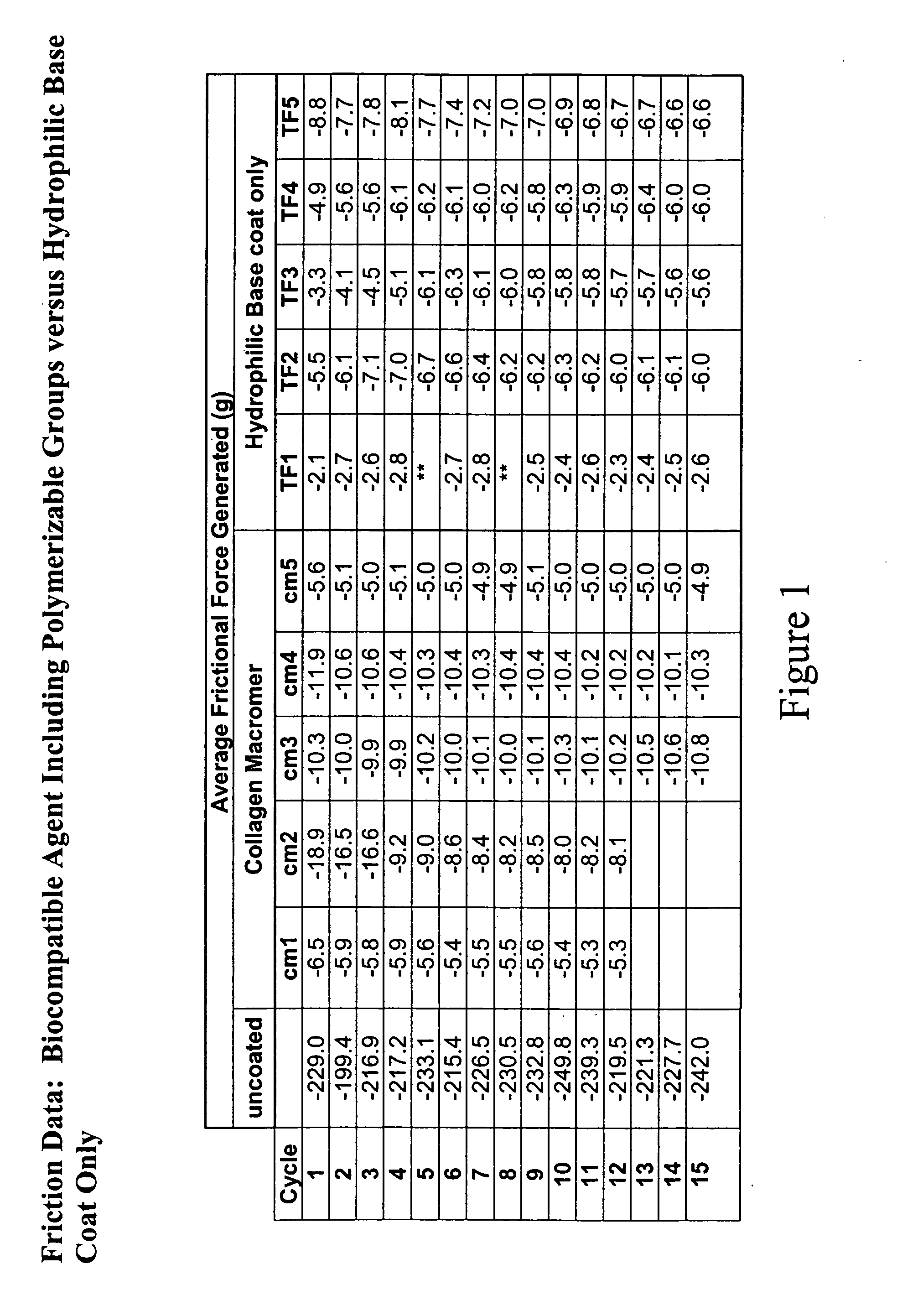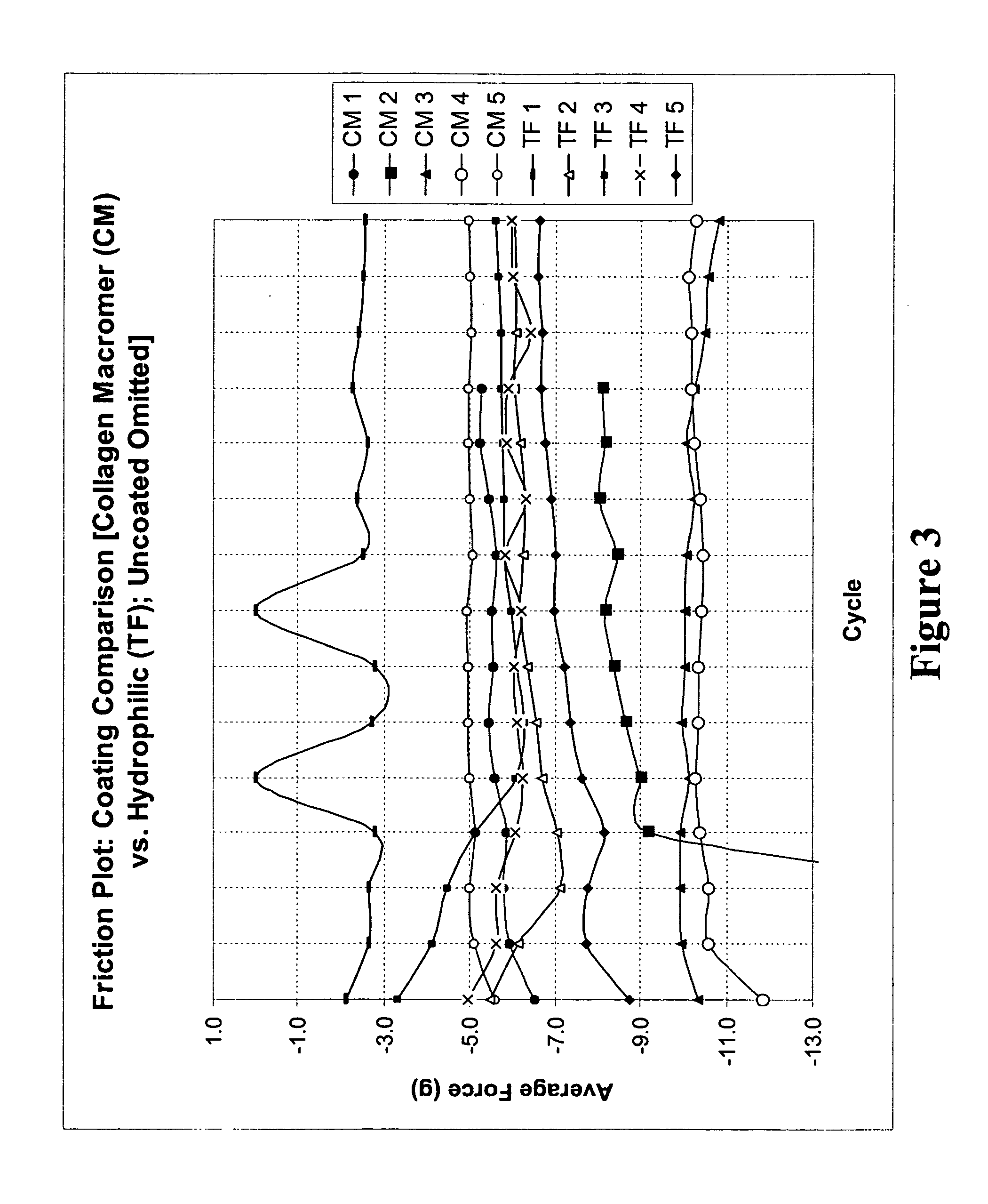Multifunctional medical articles
a multi-functional, medical device technology, applied in the field of medical articles, can solve the problems of increasing the complexity of the structure and function of the device, the limited use of surgical grade metals in early implantable medical devices, and the inability to meet the needs of patients, so as to increase the frictional force and enhance the durability
- Summary
- Abstract
- Description
- Claims
- Application Information
AI Technical Summary
Benefits of technology
Problems solved by technology
Method used
Image
Examples
example 1
Preparation of a Trimethylolpropane Ethoxylate (20 / 3 EO / OH) Triacrylate Macromer (Compound I)
[0211] A PEG-based macromer was synthesized as follows (synthesis scheme represented at the end of this Example).
[0212] Trimethylolpropane ethoxylate (PEG-triol; 100.0 g, 98.6 mmoles; Average Mw approximately 1,104; Cat. No. 41,617-7; Aldrich Chemical Company, Inc., Milwaukee, Wis.) was dissolved in 200 mls of toluene with stirring and refluxed for one hour. The PEG-triol solution was allowed to cool to approximately 80° C. At this time, 50 mg (0.403 mmoles) of 4-methoxyphenol (MEHQ; J. T. Baker, Phillipsburg, N.J.), 42.7 g (0.592 moles) of acrylic acid (J. T. Baker, Phillipsburg, N.J.), and 10 mls (0.188 moles) of sulfuric acid (Aldrich Chemical Company, Inc., Milwaukee, Wis.) were added with stirring to the reaction solution. The reaction solution was heated to reflux. The reaction was allowed to progress until about 6.0 mls of water was produced and collected via a Dean & Stark receiver...
example 2
Preparation of Photoheparin (Compound II)
[0214] A photoreactive derivative of heparin (photoheparin) was prepared by reacting heparin with benzoyl-benzoyl-epsilon-aminocaproyl-N-oxysuccinimide in dimethylsulfoxide / carbonate suffer, pH 9.0. The solvent was evaporated and the photoheparin was dialyzed against water, and lyophilized, and then dissolved in water at 3 mg / ml. The product is referred to as BBA-EAC-heparin (referring to the benzophenone photoreactive group benzoyl benzoic acid, BBA; and the spacer, epsilon aminocaproic acid, EAC).
example 3
Preparation of Photocollagen
[0215] A photoreactive derivative of type IV collagen (photocollagen) was prepared as follows. Human placental type IV collagen was obtained from Sigma Chemical Co., St. Louis, Mo. A heterobifunctional crosslinking agent (BBA-EAC-NOS) was synthesized and used to photoderivatize the collagen.
[0216] The BBA-EAC-NOS includes a benzophenone photoreactive group (BBA), a spacer (EAC) and an amine reactive thermochemical coupling group (N-oxysuccinimide, NOS). BBA-EAC was synthesized from 4-benzoylbenzoyl chloride and 6-aminocaproic acid. Then the NOS ester of BBA-EAC was synthesized by esterifying the carboxy group of BBA-EAC by carbodiimide activation with N-hydroxysuccinimide to yield BBA-EAC-NOS.
[0217] Type IV collagen was photoderivatized by covalently coupling primary amines on the protein via the NOS ester of BBA-EAC-NOS. The BBA-EAC-NOS was added at a ratio of 10-15 moles of BBA-EAC-NOS per mole of collagen.
PUM
| Property | Measurement | Unit |
|---|---|---|
| melting temperatures | aaaaa | aaaaa |
| wavelength range | aaaaa | aaaaa |
| height | aaaaa | aaaaa |
Abstract
Description
Claims
Application Information
 Login to View More
Login to View More - R&D
- Intellectual Property
- Life Sciences
- Materials
- Tech Scout
- Unparalleled Data Quality
- Higher Quality Content
- 60% Fewer Hallucinations
Browse by: Latest US Patents, China's latest patents, Technical Efficacy Thesaurus, Application Domain, Technology Topic, Popular Technical Reports.
© 2025 PatSnap. All rights reserved.Legal|Privacy policy|Modern Slavery Act Transparency Statement|Sitemap|About US| Contact US: help@patsnap.com



